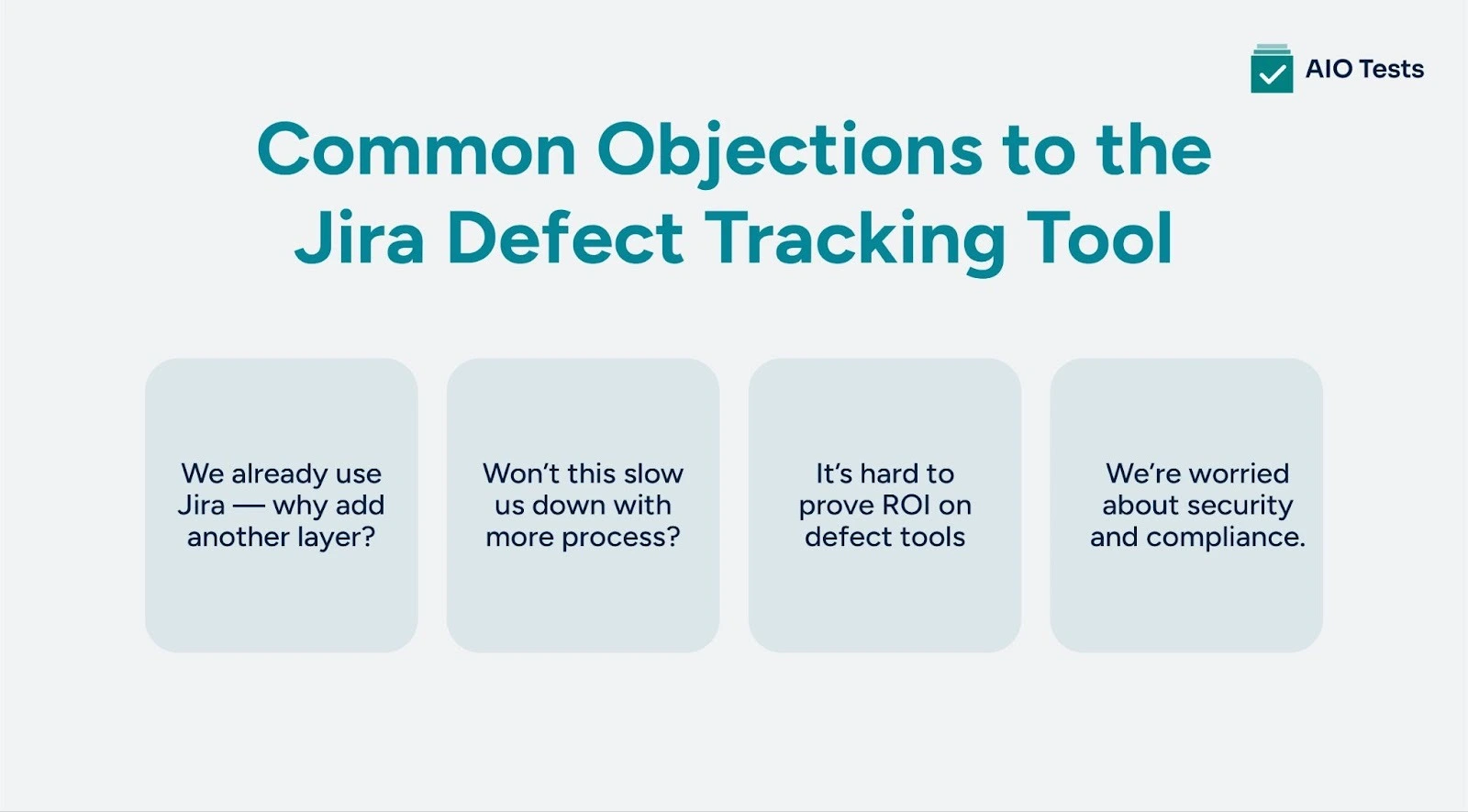Quick Summary
A Jira defect tracking tool is essential for agile teams to catch bugs early, speed up resolution, and improve release quality. Learn six key ways Jira enhances QA, reduce testing bottlenecks, and learn what features to prioritize when choosing the right defect tracking solution.
Here’s how top QA and DevOps leaders are finally conquering the endless bug backlog, slowing release cadence, and quality slip‑ups — by adopting a purpose-built Jira defect tracking tool.
Agile teams are under constant pressure to ship faster without sacrificing quality. But without a structured defect tracking system, even the best agile testing cycles get derailed by hidden bugs, unclear ownership, and last-minute surprises.
That’s where a mature Jira bug management system makes all the difference. It streamlines the entire defect lifecycle from discovery to resolution while giving your team real-time visibility, traceability, and control.
This blog shows you six ways the right Jira defect tracking tool can transform your agile testing process.
How Do Hidden Defects Impact Agile Velocity and Software Quality?
Even the most mature agile teams aren’t immune to defects. According to Diffblue, you’ll encounter 70 bugs per 1,000 lines of code, and without effective tracking, up to 15 of those can slip into production.
That’s not just a QA issue. It’s a business risk.
In agile environments where speed is everything, delayed defect resolution leads to sprint spillovers, release rollbacks, unhappy stakeholders, and an ever-growing pile of technical debt.
Here’s the problem: most teams treat Jira like a basic to-do list. But using Jira issue tracking software as a generic task board without tailoring it for defect management leads to lost context, duplicate bugs, poor visibility, and inefficient triage.

Still thinking, “We already use Jira, we’re good”? Not quite. Without a proper Jira defect tracking tool built with custom workflows, triage flows, and QA-Dev integration, you’re leaving major value on the table.
The result? Slower velocity. More hotfixes. Burnt-out teams. And a QA process that quietly undermines your agile goals.
What Should a Jira Defect Tracking Tool Deliver to QA Teams?
A modern Jira defect tracking tool isn’t just a way to log bugs. It’s a strategic layer in your agile QA process, one that closes the feedback loop between testers, developers, and product owners.
When configured properly (or enhanced with the right add-ons), a Jira issue tracking tool gives you:
- A single source of truth for all test defects
- Real-time visibility into defect status and ownership
- Traceability from user story to test case to bug fix
- Workflow automation to enforce SLAs and reduce manual follow-ups
- Data-driven insights to improve test quality and reduce escape rates
Here’s a simple framework that top teams follow when implementing a Jira QA defect management system:
- Capture defects consistently — make it easy for QA, Dev, and even Product to log bugs with required metadata.
- Prioritize fast — assign severity, impact, and component tags to avoid triage delays.
- Link bugs to work items — connect defects to epics, user stories, and test cases so nothing gets orphaned.
- Automate workflows — use Jira rules to auto-assign, notify, and update tickets in real-time.
- Measure relentlessly — track defect age, cycle time, and root causes through Jira dashboards.
- Promote cross-team ownership — QA and Dev work in the same system, aligned around clear status and expectations.
How Can Jira Defect Tracking Tools Improve Agile Testing in 6 Key Ways?
When you deploy the right Jira defect tracking tool, you’re transforming your testing process into a strategic lever for quality, speed, and agility.
Here’s how:
1. Accelerated defect discovery & logging
In agile testing, speed matters. A Jira defect tracking tool enables testers (and even developers) to capture defects at the moment they are found during a sprint, a test run or even via CI / CD tooling. According to Atlassian, one of the core benefits of such tools is “efficient bug identification and recording” via a centralized platform.
With this speed:
- You reduce the lag between discovery and logging.
- You minimise loss of context (environment, steps to reproduce, screenshot).
- You trigger triage and resolution sooner, which keeps sprints from spilling over.
This means your Jira bug tracking becomes proactive, not reactive.
2. Improved visibility across QA and development
Visibility is the missing link in many testing workflows. A properly configured Jira issue tracking software gives everyone a unified view of defect status, backlog, age, and resolution time. For example, in agile environments, Jira issue tracking supports dashboards and custom views to surface blockers and bottlenecks.
With this kind of visibility:
- You identify high‑risk defects early.
- Stakeholders are aligned on priorities.
- Sprint planning becomes more realistic because you see the real defect load, not an estimate.
- Collaboration improves — QA isn’t hidden, Dev knows what QA is finding, Product understands the impact.
3. Traceability from requirement → test → defect → fix
One of the biggest wins of a mature Jira QA defect management approach is end‑to‑end traceability. When defects are linked back to user stories or requirements, and then to tests and fix deployments, you get:
- Full context for each defect: what requirement it traces to, which test found it, and which sprint it sits in.
- Better audits and stakeholder updates (e.g., “this bug came out of feature X’s test suite”).
- Lower risk of orphaned defects or blind spots in your release.
Tools built on Jira support this traceability, and many test-management add-ons emphasize the advantage of defect tracking, traceability, and traceability analysis through such linked workflows. For an agile team adopting a Jira issue tracking tool, this means fewer surprises post‑release and better alignment between QA, Dev and Product.
4. Prioritisation and risk‑based defect management
In agile testing, you don’t have time for every bug to get equal treatment. A smart Jira issue tracking software lets you classify defects by severity, component, impact, or release blocker and then route them accordingly.
According to Atlassian’s guidance on bug‑tracking best practices, effective tools enable “prioritisation and workflow management” for bugs. When you apply this in QA:
- Critical defects surface at the top of backlogs and get sprint‑time treatment.
- Minor cosmetic bugs may be scheduled later or bundled.
- You reduce sprint disruption because the team isn’t chasing low‑impact issues while high‑impact ones languish. This kind of prioritisation turns your Jira defect tracking tool into a risk‑management asset, not just a bug list.
5. Faster resolution cycles and continuous feedback
The whole point of agile is short cycles — so that you can feedback, fix, and iterate. With the right Jira bug management system, your defect lifecycle shrinks: capture → triage → assignment → fix → verification → closure. Using Jira’s built‑in workflows and automation (custom issue types, triggers, notifications) supports this.
Here’s what happens when you accelerate resolution:
- Less waiting for ownership or status updates.
- Blockers freed up quickly.
- Sprint velocity remains stable because defects don’t become hidden drag.
- Post‑release risk drops because fewer defects escape to production. For a QA/Dev team ready to use a dedicated Jira defect tracking tool, this means fewer hot‑fix cycles and more predictable releases.
6. Data‑driven improvement of QA/Dev processes
A Jira issue tracking software gives you analytics: defect age, resolution time, recurrence rate, modules with high defect density, and root‑cause trends. Bug detection and frequent feedback loops are benefits of agile testing, but you still need data to learn from past cycles.
And Atlassian emphasises dashboards and reports in bug tracking (bug templates, reports via Jira) as key capabilities.
When you leverage that data:
- You spot that Module X has 30 % of your defects → allocate more QA or refactor code.
- Your mean time to fix is creeping up → examine hand‑offs and responsibilities.
- The escape rate (bugs reaching production) trends down → submit that as a win to leadership. In other words, your Jira defect tracking tool becomes an engine for continuous improvement, not just a reactive system.
What Should You Look for When Choosing a Jira Issue Tracking Tool?
Choosing the right Jira defect tracking tool is about empowering your QA and Dev teams to deliver faster, cleaner releases and strengthen overall software quality assurance.
Here’s a straightforward checklist to guide your evaluation:
If your solution checks most or all of these boxes, you’re on track to implement a Jira-based defect tracking system that supports agility, quality, and visibility at scale.
What Are the Most Common Objections to Jira Defect Tracking Tools (and How to Overcome Them)?
Even teams that struggle with defects often hesitate to invest in a dedicated Jira defect tracking tool. Let’s unpack the most common objections.

- “We already use Jira — why add another layer?”
Fair question. But simply logging bugs in generic Jira tickets doesn’t equal real defect management. Without tailored workflows, traceability, test automation, and QA-specific reporting, most teams miss critical insights, lose context, and delay resolution.
A dedicated Jira issue tracking tool transforms Jira into a true QA asset.
- “Won’t this slow us down with more process?”
Only if it’s done wrong, the right setup supports agility, not bureaucracy. You can automate assignments, streamline hand-offs, and trigger alerts and all while keeping your existing workflows intact.
Done right, a Jira bug tracking system actually speeds things up by reducing manual follow-ups and improving collaboration.
- “It’s hard to prove ROI on defect tools.”
Not true. When defects are managed properly, you reduce sprint spillovers, avoid release rollbacks, and decrease hotfixes. All of which have a real cost and you gain visibility into defect patterns that inform smarter decisions.
Your team will spend less time firefighting and more time building.
- “We’re worried about security and compliance.”
Totally valid. But mature Jira issue tracking software supports role-based access, audit logs, and secure data handling. These are all baked into Jira’s core or via trusted add-ons. You stay in control, and your data stays protected.
Conclusion
Agile testing doesn’t fail because bugs happen; it fails when they’re not tracked, prioritized, and resolved fast enough.
The right Jira defect tracking tool transforms your QA process from reactive to reliable. You get early bug detection, traceability from test to fix, faster resolution cycles, and the data to improve sprint over sprint.
AIO Tests delivers all of this and more.
It’s a Jira-native test management tool built for agile teams that want end-to-end visibility, test-defect traceability, custom QA workflows, and real-time reporting all inside Jira. If you're ready to streamline your testing, tighten your feedback loops, and ship cleaner code, AIO Tests is the last QA tool you’ll need.
Book a free demo of AIO Tests and see how top agile teams are managing defects with speed, structure, and confidence.

FAQs
- What is a Jira defect tracking tool?
A Jira defect tracking tool helps teams log, track, and resolve software defects efficiently. It provides customizable workflows, real-time updates, and reporting dashboards. This ensures faster bug resolution and better release quality.
- How does Jira issue tracking software improve collaboration between QA and development teams?
Jira issue tracking software centralizes defect data, making it visible to both QA and development teams. Everyone can track status updates and progress in real-time. This alignment reduces miscommunication and speeds up resolution.
- What are the best practices for using Jira bug tracking to prevent defects?
Use a central system to log all defects with clear severity and impact tags. Link defects to user stories and test cases for traceability. Prioritize and resolve high-impact issues first to avoid production leaks.
- How can a Jira QA defect management system contribute to continuous improvement in agile teams?
It provides analytics on defect trends, resolution times, and recurrence rates. Teams can identify patterns and address root causes. This drives smarter decisions and continuous quality improvement, sprint after sprint.







.svg)
